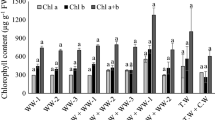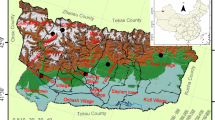Abstract
The risk assessment of trace elements has received substantial attention for the achievement of UN Sustainable Developmental Goals (UN-SDGs). The present study aimed to evaluate health and ecological risks associated with trace element accumulation in Brassica oleracea under wastewater irrigations from three different areas. This study, for the first time, compared the pros and cons of mixed water crop irrigation (wastewater with fresh/groundwater). A pot experiment was conducted to evaluate the buildup of eight trace elements (As, Cu, Cd, Mn, Fe, Pb, Ni and Zn) in soil and B. oleracea plants irrigated with wastewater alone and mixed with fresh/groundwater. Specific ecological [degree of contamination (Cd), potential ecological risk index (PERI), pollution load index (PLI), geo-accumulation index (Igeo)], phytoaccumulation [bioconcentration factor (BCF) and transfer factor (TF)] and health risk models [chronic daily intake (CDI), hazard quotient (HQ), cancer risk (CR)] were applied to assess the overall contamination of trace elements in the soil–plant–human system. Moreover, these indices were compared with the literature data. The concentration of Cd, Fe and Mn exceeded the threshold limits of 10, 500 and 200 mg kg−1, respectively, for agricultural soil. Overall, all the irrigation waters caused significant pollution load in soil indicating high ecological risk (Cd > 24, PERI > 380, Igeo > 5, PLI > 2). Not all the mixing treatments caused a reduction in trace element buildup in soil. The mixing of wastewater-1 with either groundwater or freshwater increased trace element levels in the soil as well as risk indices compared to wastewater alone. The BCF and TF values were > 1, respectively, for 66% and 7% treatments. Trace element concentration in plants and associated health risk were minimized in mixed wastewater treatments. There were 22% and 32% reduction in HQ and CR when wastewater was mixed with freshwater and 29% and 8% when mixed with groundwater. Despite total reduction, a great variation in % change in risk indices was observed with respect to the area of wastewater collection. Therefore, mixed water irrigation may be a good management strategy, but its recommendation depends on soil properties and composition of waters used for mixing. Moreover, it is recommended that the freshwater and wastewater of the particular area may be continuously monitored to avoid potential associated health hazards.

Similar content being viewed by others
References
Abdullah Al-Dhabi, N., & Arasu, M. V. (2022). Biosorption of hazardous waste from the municipal wastewater by marine algal biomass. Environmental Research, 204, 112115.
Anwar, H., Shahid, M., Natasha, Niazi, N.K., Khalid, S., Tariq, T.Z., Ahmad, S., Nadeem, M., Abbas, G., (2021). Risk assessment of potentially toxic metal (loid) s in Vigna radiata L. under wastewater and freshwater irrigation. Chemosphere, 129124.
Ashraf, I., Ahmad, F., Sharif, A., Altaf, A. R., & Teng, H. (2021). Heavy metals assessment in water, soil, vegetables and their associated health risks via consumption of vegetables, District Kasur. Pakistan. SN Applied Sciences, 3, 552.
Cosgrove, W. J., & Loucks, D. P. (2015). Water management: Current and future challenges and research directions. Water Resources Research, 51, 4823–4839.
Dumat, C., Pelfrêne, A., & Shahid, M. (2019). Environment-health link in a context of urban agricultures: Studies of oral exposure to pollutants in order promote the human health. Environmental Science and Pollution Research, 26, 20015–20017.
Graefe, S., Buerkert, A., Schlecht, E., (2019). Trends and gaps in scholarly literature on urban and peri-urban agriculture. Nutrient Cycling in Agroecosystems, pp. 1–16.
Gul, I., Manzoor, M., Hashim, N., Shah, G.M., Waani, S.P.T., Shahid, M., Antoniadis, V., Rinklebe, J., Arshad, M., (2021). Challenges in microbially and chelate-assisted phytoextraction of cadmium and lead–A review. Environmental Pollution, p. 117667.
Hakanson, L. (1980). An ecological risk index for aquatic pollution control. A Sedimentological Approach. Water Research, 14, 975–1001.
Iqbal, Z., Abbas, F., Ibrahim, M., Qureshi, T. I., Gul, M., & Mahmood, A. (2020). Human health risk assessment of heavy metals in raw milk of buffalo feeding at wastewater-irrigated agricultural farms in Pakistan. Environmental Science and Pollution Research, 27, 29567–29579.
Kabata-Pendias, A., (2011). Trace elements in soils and plants, Third ed. CRC press.
Khalid, S., Shahid, M., Niazi, N. K., Murtaza, B., Bibi, I., & Dumat, C. (2017). A comparison of technologies for remediation of heavy metal contaminated soils. Journal of Geochemical Exploration, 182, 247–268.
Li, Q.-G., Liu, G.-H., Qi, L., Wang, H.-C., Ye, Z.-F., & Zhao, Q.-L. (2022). Heavy metal-contained wastewater in China: Discharge, management and treatment. Science of the Total Environment, 808, 152091.
MDGs. (2015). The millennium development goals report 2015. United Nations.
Minhas, P. S., Saha, J. K., Dotaniya, M. L., Sarkar, A., & Saha, M. (2022). Wastewater irrigation in India: Current status, impacts and response options. Science of the Total Environment, 808, 152001.
Natasha, Bibi, I., Hussain, K., Amen, R., Hasan, I.M.U., Shahid, M., Bashir, S., Niazi, N.K., Mehmood, T., Asghar, H.N., Nawaz, M.F., Hussain, M.M., Ali, W., (2021a). The potential of microbes and sulfate in reducing arsenic phytoaccumulation by maize (Zea mays L.) plants. Environ Geochem Health.
Natasha, Shahid, M., Khalid, S., Murtaza, B., Anwar, H., Shah, A.H., Sardar, A., Shabbir, Z., Niazi, N.K., (2020a). A critical analysis of wastewater use in agriculture and associated health risks in Pakistan. Environmental geochemistry and health.
Natasha, Shahid, M., Khalid, S., Niazi, N.K., Murtaza, B., Ahmad, N., Farooq, A., Zakir, A., Imran, M., Abbas, G., (2021b). Health risks of arsenic buildup in soil and food crops after wastewater irrigation. Science of The Total Environment 772, 145266.
Natasha MKhalidSaleem, S. S. M. (2022). Unrevealing arsenic and lead toxicity and antioxidant response in spinach: A human health perspective. Environmental Geochemistry and Health, 44, 487–496.
Natasha M, S., Niazi, N. K., Rinklebe, J., Bundschuh, J., Dumat, C., & Pinelli, E. (2020). Trace elements-induced phytohormesis: A critical review and mechanistic interpretation. Critical Reviews in Environmental Science and Technology, 50, 1984–2015.
Natasha, Shahid, M., Sardar, A., Anwar, H., Khalid, S., Shah, S.H., Shah, A.H., Bilal, M., (2020c). Effect of co-application of wastewater and freshwater on the physiological properties and trace element content in Raphanus sativus: soil contamination and human health. Environmental Geochemistry and Health, pp. 1–14.
Natasha, N., Shahid, M., Bibi, I., Iqbal, J., Khalid, S., Murtaza, B., Bakhat, H. F., Farooq, A. B. U., Amjad, M., Hammad, H. M., Niazi, N. K., & Arshad, M. (2022). Zinc in soil-plant-human system: A data-analysis review. Science of the Total Environment, 808, 152024.
Natasha, N., Shahid, M., Khalid, S., Niazi, N.K., Murtaza, B., Ahmad, N., Farooq, A., Zakir, A., Imran, M., Abbas, G., (2021c). Health risks of arsenic buildup in soil and food crops after wastewater irrigation. Science of The Total Environment, 145266.
Parvanak, K., & Khamisabadi, A. (2020). Evaluating contamination impact of wastewater irrigation to soils in Zahedan. Iran. Environmental Geochemistry and Health, 42, 4269–4280.
Parvez, S., Abbas, G., Shahid, M., Amjad, M., Hussain, M., Asad, S.A., Imran, M., Naeem, M.A., (2020). Effect of salinity on physiological, biochemical and photostabilizing attributes of two genotypes of quinoa (Chenopodium quinoa Willd.) exposed to arsenic stress. Ecotoxicology and environmental safety 187, 109814.
Sarwar, T., Shahid, M., Natahsa, Khalid, S., Shah, A.H., Ahmad, N., Naeem, M.A., ul Haq, Z., Murtaza, B., Bakhat, H.F., (2020). Quantification and risk assessment of heavy metal build-up in soil–plant system after irrigation with untreated city wastewater in Vehari, Pakistan. Environmental geochemistry and health 42, 4281-4297
Shabbir, Z., Sardar, A., Shabbir, A., Abbas, G., Shamshad, S., Khalid, S., Natasha, N., Murtaza, G., Dumat, C., Shahid, M., (2020a). Copper uptake, essentiality, toxicity, detoxification and risk assessment in soil-plant environment. Chemosphere, 127436.
Shabbir, Z., Shahid, M., Natasha, Khalid, S., Khalid, S., Imran, M., Qureshi, M.I., Niazi, N.K., (2020b). Use of agricultural bio-wastes to remove arsenic from contaminated water. Environmental geochemistry and health.
Shah, A.H., Shahid, M., Khalid, S., Natahsa, Shabbir, Z., Bakhat, H.F., Murtaza, B., Farooq, A., Akram, M., Shah, G.M., Nasim, W., (2020). Assessment of arsenic exposure by drinking well water and associated carcinogenic risk in peri-urban areas of Vehari, Pakistan. Environmental geochemistry and health 42, 121-133
Shahid, M. (2021). Effect of soil amendments on trace element-mediated oxidative stress in plants: Meta-analysis and mechanistic interpretations. Journal of Hazardous Materials, 407, 124881.
Shahid, M., Niazi, N. K., Dumat, C., Naidu, R., Khalid, S., Rahman, M. M., & Bibi, I. (2018). A meta-analysis of the distribution, sources and health risks of arsenic-contaminated groundwater in Pakistan. Environmental Pollution, 242, 307–319.
Shahid, M., Pourrut, B., Dumat, C., Nadeem, M., Aslam, M., Pinelli, E., (2014). Heavy-Metal-Induced Reactive Oxygen Species: Phytotoxicity and Physicochemical Changes in Plants. Reviews of Environmental Contamination and Toxicology Volume 232. Springer, pp. 1–44.
Shahsavari, A. A., Khodaei, K., Asadian, F., Ahmadi, F., & Zamanzadeh, S. M. (2012). Groundwater pesticides residue in the southwest of Iran-Shushtar plain. Environmental Earth Sciences, 65, 231–239.
Tang, B., Xu, H., Song, F., Ge, H., & Yue, S. (2022). Effects of heavy metals on microorganisms and enzymes in soils of lead–zinc tailing ponds. Environmental Research, 207, 112174.
UN-SGD, (2016). Sustainable development goals report 2016. United Nations.
Zhang, X., Wang, X., Cao, X., Xiao, G., & Miao, H. (2022). Heavy element contents of vegetables and health-risk assessment in China. Science of the Total Environment, 828, 154552.
Acknowledgements
Dr. M Shahid thanks HEC-Pakistan for financing a project (20-4423/R&D/HEC/14/980). Authors thank the Researchers Supporting Project number (RSP-2021/169), King Saud University, Riyadh, Saudi Arabia for the financial support.
Data availability statement
All data produced and analyzed during this study are incorporated in this article and supplementary material.
Author information
Authors and Affiliations
Contributions
AHS performed the research work and write-up of first draft; MS performed conceptualization, analysis, writing/improving first draft and supervision; MT, IB, TZT and SK reviewed and edited manuscript; NN helped in research work and improved the first draft; MN, GA and MFS co-supervised research work; and SA and CD made final revision, editing and improvement.
Corresponding author
Ethics declarations
Conflict of interest
The authors declare no conflict of interest.
Human and Animal rights
Not applicable.
Consent to participate
Not applicable.
Consent to publish
Not applicable.
Additional information
Publisher's Note
Springer Nature remains neutral with regard to jurisdictional claims in published maps and institutional affiliations.
Supplementary Information
Below is the link to the electronic supplementary material.
Rights and permissions
Springer Nature or its licensor holds exclusive rights to this article under a publishing agreement with the author(s) or other rightsholder(s); author self-archiving of the accepted manuscript version of this article is solely governed by the terms of such publishing agreement and applicable law.
About this article
Cite this article
Shah, A.H., Shahid, M., Tahir, M. et al. Risk assessment of trace element accumulation in soil and Brassica oleracea after wastewater irrigation. Environ Geochem Health 45, 8929–8942 (2023). https://doi.org/10.1007/s10653-022-01351-4
Received:
Accepted:
Published:
Issue Date:
DOI: https://doi.org/10.1007/s10653-022-01351-4




